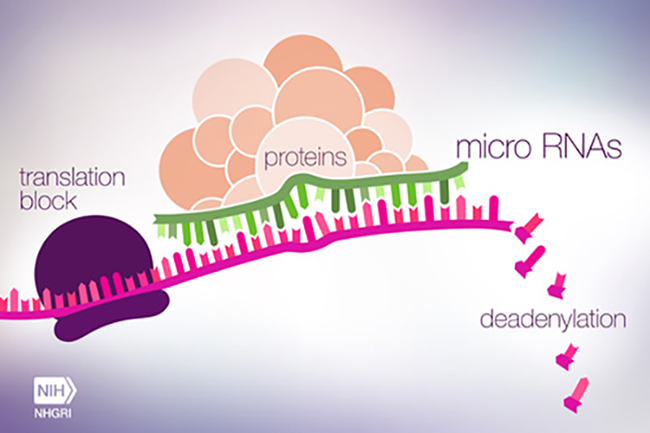Increasingly, cancer researchers are discovering novel biological pathways that regulate the expression of various genes that are often strongly associated with tumorigenesis. These new molecular mechanisms represent important potential therapeutic targets for aggressive and difficult-to-treat cancers. In particular, microRNAs (miRNAs) small, noncoding genetic material that regulates gene expression have steadily become implicated in the progression of some cancers.
Now, researchers at the University of Cincinnati (UC) have found a particular signaling route for a microRNA, miR-22, that they believe leads to targets for acute myeloid leukemia (AML), the most common type of fast-growing cancer of the blood and bone marrow.
The findings from this study were published recently in Nature Communications in an article entitled “miR-22 Has a Potent Anti-Tumour Role with Therapeutic Potential in Acute Myeloid Leukaemia.”
“MicroRNAs make up a class of small, noncoding internal RNAs that control a gene’s job, or expression, by directing their target messaging RNAs, or mRNAs, to inhibit or stop. Cellular organisms use mRNA to convey genetic information,” explained senior study author Jianjun Chen, Ph.D., associate professor in the department of cancer biology at the UC College of Medicine. “Previous research has shown that microRNA miR-22 is linked to breast cancer and other blood disorders which sometimes turn into AML, but we found in this study that it could be an essential anti-tumor gatekeeper in AML when it is down-regulated, meaning its function is minimized.”
AML—most common type of acute leukemia arises when the bone marrow begins to make blasts, cells that have not yet completely matured. These blast cells typically develop into white blood cells; however, in AML the cells do not develop and are unable to aid in warding off infections. In the current study, the UC team describes how altering the expression of miR-22 affected AML pathogenesis.
“When we forced miR-22 expression, we saw difficulty in leukemia cells developing, growing, and thriving. miR-22 targets multiple cancer-causing genes (CRTC1, FLT3, and MYCBP) and blocks certain pathways (CREB and MYC),” Dr. Chen noted. “The downregulation, or decreased output, of miR-22 in AML, is caused by the loss of the number of DNA being copied and/or stopping their expression through a pathway called TET1/GFI1/EZH2/SIN3A. Also, nanoparticles carrying miR-22 DNA oligonucleotides (short nucleic acid molecules) prevented leukemia advancement.”
The investigators conducted the study using bone marrow transplant samples and animal models. The researchers showed that the ten-eleven translocation proteins (TET1/2/3) in mammals helped to control genetic expression in normal developmental processes. This was in sharp contrast to mutations that cause function loss and tumor-slowing with TET2, which has been observed previously in blood and stem cell cancers.
“We recently reported that TET1 plays an essential cancer generating role in certain AML where it activates expression of homeobox genes, which are a large family of similar genes that direct the formation of many body structures during early embryonic development,” remarked Dr. Chen. “However, it is unknown whether TET1 can also function as a repressor for cellular function in cancer, and its role in microRNA expression has rarely been studied.”
Dr. Chen added that these findings are important in targeting a cancer that is both common and fatal, stating that “the majority of patients with ALM usually don’t survive longer than 5 years, even with chemotherapy, which is why the development of new effective therapies based on the underlying mechanisms of the disease is so important.”
“Our study uncovers a previously unappreciated signaling pathway (TET1/GFI1/EZH2/SIN3A/miR-22/CREB-MYC) and provides new insights into genetic mechanisms causing and progressing AML and also highlights the clinical potential of miR-22-based AML therapy. More research on this pathway and ways to target it are necessary,” Dr. Chen concluded.







